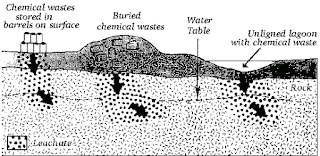Todays article will be all about the disposing of chemical waste and/or unwanted chemicals. First off lets define exactly what chemical waste is before we get into detail. According to the site http://gogreenplus.org/nuts-and-bolts-guide/planet-nuts-and-bolts-guide/waste-reduction-responsible-disposal/disposing-of-hazardous-waste/ , hazardous waste is any waste that poses a threat to the health of humans or the environment. This waste can be a lot of different things, and come in a lot of forms. This waste can be solid liquid or gas and also it can be in the form of a sludge. Some people, after being in a lab or not, may not be aware that chemicals that are not used in an experiment or for production still need to be disposed of correctly. Even though a chemical is not used, it still can cause serious health affects to humans and the environment. So, what steps should you take of disposing chemicals? Well, according to the site http://smallbusiness.chron.com/dispose-industrial-chemicals-40938.html , the first thing you should do is check the EPA hazardous waste list. The EPA has a list of hazardous wastes that need to be disposed properly, and they also regulate hazardous waste under the Resource Conservation and Recovery Act. According to the site https://www.epa.gov/hwgenerators , the EPA regulate hazardous waste based on quantity of business in one calendar month, not how large the company is. The next thing you should do is classify what type of hazardous waste your waste is considered. There are three different categories in which the EPA classifies waste disposal. The category of waste determines how it will be disposed. These three ways of waste disposal, from the site http://smallbusiness.chron.com/dispose-industrial-chemicals-40938.html , are incineration, land disposal and underground injection. Lets talk about each of these a little bit. Incineration is an acceptable way of disposing of hazardous waste as long as the incinerator is up to code with the Clean Air Act. This means that your incinerator can not release any toxins from the incinerating process into the atmosphere. Disposing of hazardous waste on land may seem unsafe and counter productive to this article. Doesn't it seem hazardous? Well, disposing of hazardous waste in landfills is acceptable, if it goes through technological treatments before hand to make it safe to be placed in these landfills. Lastly, you can store waste in an underground injection well. This, along with putting the hazardous waste in a landfill, may seem very unsafe. Why is it okay to put this hazardous waste underground where it can contaminate things? Well, this is acceptable to dispose underground because it is highly regulated. The Safe Water Drinking Act has many regulations when looking at waste disposal and companies who dispose of this waste need to make sure they are in compliance with them in order to inject their hazardous waste deep into the Earth. Also, the Underground Injection Control Program has heavy regulations on this process, to make sure that people disposing of these hazardous materials are doing it properly and following protocol. I hope this article was helpful in providing some useful information to you about disposing of hazardous and unwanted chemicals.


No comments:
Post a Comment